新媒体背景下新能源汽车品牌营销策略英文文献
- 格式:docx
- 大小:13.29 KB
- 文档页数:3
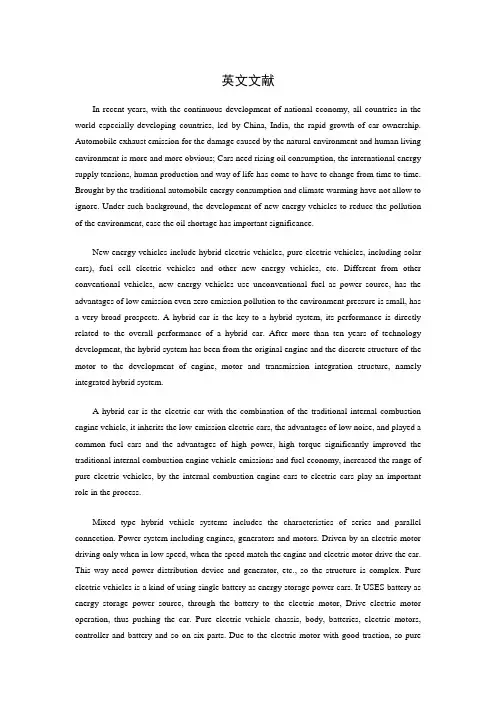
英文文献In recent years, with the continuous development of national economy, all countries in the world especially developing countries, led by China, India, the rapid growth of car ownership. Automobile exhaust emission for the damage caused by the natural environment and human living environment is more and more obvious; Cars need rising oil consumption, the international energy supply tensions, human production and way of life has come to have to change from time to time. Brought by the traditional automobile energy consumption and climate warming have not allow to ignore. Under such background, the development of new energy vehicles to reduce the pollution of the environment, ease the oil shortage has important significance.New energy vehicles include hybrid electric vehicles, pure electric vehicles, including solar cars), fuel cell electric vehicles and other new energy vehicles, etc. Different from other conventional vehicles, new energy vehicles use unconventional fuel as power source, has the advantages of low emission even zero emission pollution to the environment pressure is small, has a very broad prospects. A hybrid car is the key to a hybrid system, its performance is directly related to the overall performance of a hybrid car. After more than ten years of technology development, the hybrid system has been from the original engine and the discrete structure of the motor to the development of engine, motor and transmission integration structure, namely integrated hybrid system.A hybrid car is the electric car with the combination of the traditional internal combustion engine vehicle, it inherits the low-emission electric cars, the advantages of low noise, and played a common fuel cars and the advantages of high power, high torque significantly improved the traditional internal combustion engine vehicle emissions and fuel economy, increased the range of pure electric vehicles, by the internal combustion engine cars to electric cars play an important role in the process.Mixed type hybrid vehicle systems includes the characteristics of series and parallel connection. Power system including engines, generators and motors. Driven by an electric motor driving only when in low speed, when the speed match the engine and electric motor drive the car. This way need power distribution device and generator, etc., so the structure is complex. Pure electric vehicles is a kind of using single battery as energy storage power cars. It USES battery as energy storage power source, through the battery to the electric motor, Drive electric motor operation, thus pushing the car. Pure electric vehicle chassis, body, batteries, electric motors, controller and battery and so on six parts. Due to the electric motor with good traction, so pureelectric vehicle drive system does not need the clutch and transmission. Speed regulation system of speed control by the controller through change the speed of the electric motor can be realized. And the difference from the hybrid, pure electric vehicles as a device without the use of internal combustion engine completely, also do not use fuels such as gasoline, diesel, but completely use rechargeable batteries.The advantage of pure electric vehicles is: first, it itself is not the harmful gas of atmospheric pollution emissions. Even by the equivalent power consumption of power plant emissions, in addition to sulfur and particulate matter, other pollutants was also significantly reduced, because most of power plants built in away from the densely populated cities, less damage in humans, and power plants is stationary, concentration of emissions, remove all kinds of harmful emissions more easily, also have the relevant technology. Due to power can be obtained from a variety of primary energy, such as coal, hydropower, nuclear power, lifting the people fear of petroleum resources became more and more dried up. Second, pure electric vehicles can also make full use of the night when trough the surplus electricity power, make the generating equipment can make full use of day and night, greatly improve the economic benefit. In addition, the pure electric vehicle structure is simple, operation and less driving part, maintenance is convenient.At present, the pure electric vehicles there are still some technical defects. The main problem is the battery unit weight to store too much electricity, once after a full charge mileage is not ideal; At the same time, high reserves battery service life is short, the cost is high, make the overall cost is higher, pure electric vehicles, of course, it's none of pure electric vehicles to realize commercialization, also can't form scale economy. Therefore, the development of a wide range of pure electric vehicles is the top priority of the development of advanced battery.Fuel cell car fuel cell is used as the power source of electric vehicles. The battery energy is through the chemistry of hydrogen and oxygen, directly into electricity. Storage of hydrogen and oxygen in the air in the fuel cell produces chemical reaction, generate electricity to start the motor, so as to drive the car. In addition, methanol, hydrogen gas, gasoline, diesel oil can replace. Fuel cell in the process of chemical reaction without burning, so the fuel cell car is no pollution to the environment. At the same time, the energy conversion efficiency of fuel cell is 2 to 3 times higher than the internal combustion engine, so from the aspects of energy utilization and environmental protection, is an ideal vehicle fuel cell car.Compared with the traditional vehicles, fuel cell vehicles has the following advantages: no pollution, zero emissions. To reduce the greenhouse gas emissions High energy conversion effect.Wide range of fuel selection. In recent years, great progress has been made in fuel cell technology, the world many famous automobile manufacturers such as Toyota, ford, BMW, etc are purposeful, planned to fuel cell vehicles on the market.Hydrogen powered cars are divided into hydrogen fuel cell vehicles with hydrogen internal combustion vehicle. The former with ordinary fuel cell cars, by hydrogen fuel cells in liquid hydrogen and oxygen to produce electricity in the air to push the car. With hydrogen fuel cell vehicles using different motor, hydrogen is used for car internal combustion engine, by hydrogen gas and air mixture combustion produces energy, so as to move the car. Hydrogen internal combustion vehicle in a zero discharge of hydrogen fuel-cell cars, no pollution, etc.Befoul refers to product or its by-products of agriculture and forestry, industrial waste, living garbage and other biological organism and its metabolic waste as raw material for making fuel. In most cases, "befoul" used to specifically to ethanol, methanol, a liquid fuels such as bodies. Befouls mainly include biological diesel cars and fuel ethanol car.New energy cars represent the future of the world automobile industry development direction, is the commanding heights of the world automobile industry in the future. Vigorously develop new energy vehicles is the world's countries and major automakers common strategic choice. Since the 2008 financial crisis, the world's major automobile production countries increase the development of new energy automotive industry as its industry competition ability, keep the sustainable economic and social development of major strategic measures. At the same time, the development of new energy vehicles but also the breach to seek a new economic growth point and the basic way to realize transportation energy transformation. Support for new energy vehicle technology and related fiscal and tax policy, has become the powerful weapon of countries to tackle the financial crisis. To that end, countries have issued a series of policies and measures to encourage domestic the development of new energy vehicles and related industry.As the world's second largest auto producer and a handful of automotive technology powerhouse, Japan, which is mainly composed of hybrid and electric vehicles in the development of new energy vehicles, leads the world in other countries. At the same time, Japan is also a hybrid car penetration of the highest. On April 12, 2010, the Japanese economy, trade and industry joint Japan each big auto companies and the academic community to set up the strategy of "a new generation of automobile research institute" announced "a new generation of automotive strategy 2010", put forward to Japan built "a new generation of new energy automobile research and development and production base". Study the development of Japan's new energy automotiveindustry will have on the development of new energy vehicles industry in China has important significance.中文文献近年来,随着国民经济的不断发展,世界各国尤其是以中国、印度为首的发展中国家的汽车保有量急剧增长。
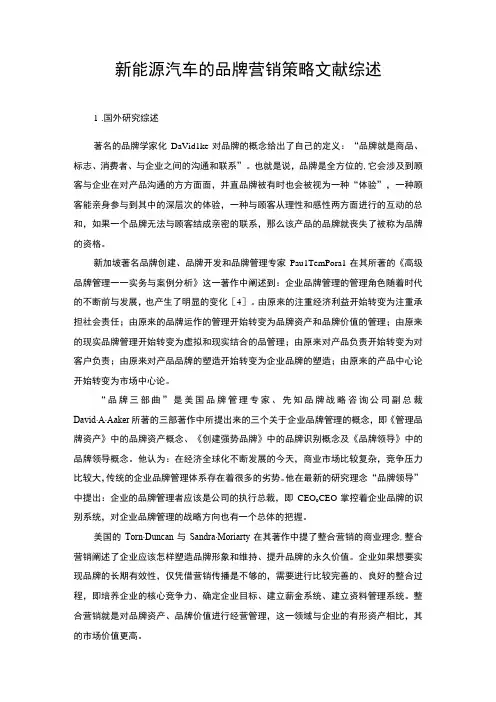
新能源汽车的品牌营销策略文献综述1.国外研究综述著名的品牌学家化DaVid1ke对品牌的概念给出了自己的定义:“品牌就是商品、标志、消费者、与企业之间的沟通和联系”。
也就是说,品牌是全方位的,它会涉及到顾客与企业在对产品沟通的方方面面,并直品牌被有时也会被视为一种“体验”,一种顾客能亲身参与到其中的深层次的体验,一种与顾客从理性和感性两方面进行的互动的总和,如果一个品牌无法与顾客结成亲密的联系,那么该产品的品牌就丧失了被称为品牌的资格。
新加坡著名品牌创建、品牌开发和品牌管理专家Pau1TemPora1在其所著的《高级品牌管理一一实务与案例分析》这一著作中阐述到:企业品牌管理的管理角色随着时代的不断前与发展,也产生了明显的变化[4]。
由原来的注重经济利益开始转变为注重承担社会责任;由原来的品牌运作的管理开始转变为品牌资产和品牌价值的管理;由原来的现实品牌管理开始转变为虚拟和现实结合的品管理;由原来对产品负责开始转变为对客户负责;由原来对产品品牌的塑造开始转变为企业品牌的塑造;由原来的产品中心论开始转变为市场中心论。
“品牌三部曲”是美国品牌管理专家、先知品牌战略咨询公司副总裁David∙A∙Aaker所著的三部著作中所提出来的三个关于企业品牌管理的概念,即《管理品牌资产》中的品牌资产概念、《创建强势品牌》中的品牌识别概念及《品牌领导》中的品牌领导概念。
他认为:在经济全球化不断发展的今天,商业市场比较复杂,竞争压力比较大,传统的企业品牌管理体系存在着很多的劣势。
他在最新的研究理念“品牌领导”中提出:企业的品牌管理者应该是公司的执行总裁,即CEO o CEO掌控着企业品牌的识别系统,对企业品牌管理的战略方向也有一个总体的把握。
美国的Torn∙Duncan与Sandra∙Moriarty在其著作中提了整合营销的商业理念,整合营销阐述了企业应该怎样塑造品牌形象和维持、提升品牌的永久价值。
企业如果想要实现品牌的长期有效性,仅凭借营销传播是不够的,需要进行比较完善的、良好的整合过程,即培养企业的核心竞争力、确定企业目标、建立薪金系统、建立资料管理系统。
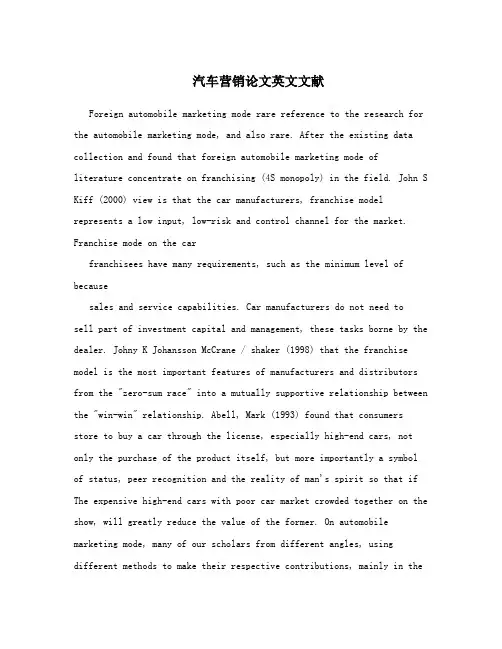
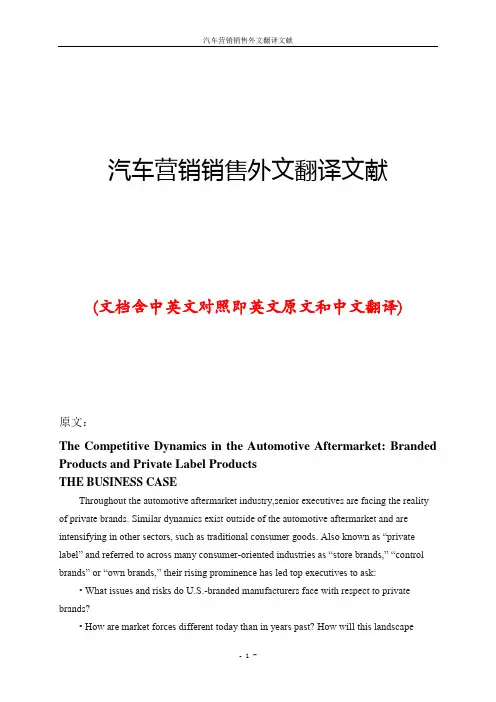
汽车营销销售外文翻译文献(文档含中英文对照即英文原文和中文翻译)原文:The Competitive Dynamics in the Automotive Aftermarket: Branded Products and Private Label ProductsTHE BUSINESS CASEThroughout the automotive aftermarket industry,senior executives are facing the reality of private brands. Similar dynamics exist outside of the automotive aftermarket and are intensifying in other sectors, such as traditional consumer goods. Also known as “private label” and referred to across many consumer-oriented industries as “store brands,” “co ntrol brands” or “own brands,” their rising prominence has led top executives to ask:• What issues and risks do U.S.-branded manufacturers face with respect to private brands?• How are market forces different today than in years past? How will this lands capeevolve?• How can I better understand my operational blind spots in an increasingly competitive landscape?• What can my management team focus on to protect and grow my brands? Where do we start?•What are the similarities and differences between the private brand trends in the automotive aftermarket and the consumer products sector?• What can be learned by automotive aftermarket executives from the private brand experiences in other sectors?Although answers to these questions are not simple and some market dynamics are not yet fully clear, the availability of private brands and other competitive trends are growing in the automotive aftermarket community, just as they are in many consumer product segments.One out of every three consumer products sold by one of the nation’s largest retailers is now private brand – up from one out of every five just a few years ago. With U.S. private brand sales in the grocery market surpassing well over $80 billion, for example, private brands can no longer be ignored by consumer product manufacturers. The U.S. market share of private brands in food, drug and mass merchant channels is more than 20 percent, according to industry data research firms. More than 80 percent of consumers shopping in big box, warehouse clubs and superstores frequently buy store brands and, depending on the specific product category, multiple store brands at a time. Retailers are focusing more resources on private branding to enhance margins, increase shelf velocity and expand store loyalty and traffic.Private branding in food, drug and mass merchant consumer products channels is not a new phenomenon, nor is it a new concept in the automotive aftermarket. However, there are differences in the degree to which private brand penetration has occurred in traditional consumer goods industries compared with the automotive aftermarket. The factors giving rise to these differences include the nature and use of the products (e.g., immediate consumption vs. durable goods), the ability of the consumer to exercise preference at point of sale, technological or other barriers to entry for alternative manufacturers to produce private brands, the degree to which products are subject to regulatory controls, and the differences in the channels in which the products are distributed. Notwithstanding these distinctions, private branding will continue to impact the competitive landscape.Consumer behavior has gone through a dramatic evolution in the past five years, with the economic shifts and downturns, and with the exploding access to information and technology. The lines of consumer priorities are blurring and shifting, and regardless of brand or product mix, measurement and management of these shifts will be the key to strategic success and growth in a global marketplace.The U.S. automotive aftermarket is one of the single largest markets in the U.S. and is increasingly affected by private brand influences similar to other consumer product markets. However, total private brand penetration in the aftermarket is not as closely measured and monitored as in other consumer sectors. As brand and product strategies continue to evolve among aftermarket channel participants, more sophisticated measurements of private brand penetration rates are beginning to take root.ISSUES, OPPORTUNITIES AND RISKSThe degree of market consolidation among retailers is believed to be one of the influences at work in driving increased private brand market share penetration. Retail consolidation is also one of the contributing factors to increasing retailer pricing leverage, according to the AASA(Automotive Aftermarket Suppliers Association) Q4 2009 Aftermarket Supplier Barometer report, and ultimately can lead to supplier margin erosion.Retail consolidation can create economy-of-scale advantages for private brands, allowing brand development and deployment costs to be spread incrementally across higher product volumes, decreasing their relative per unit volume significance. Further, private brand penetration appears to vary across product categories. Those experiencing a higher degree of “commoditization” (little or no perceived differentiation across brands) have demonstrated higher private brand market share levels compared to product categories with low degrees of commoditization. Within the automotive aftermarket, product categories such as tires, accessories and maintenance parts are showing similar trends. One recent research report for brake component sales from Frost & Sullivan shows private brands had a 60 percent market share in 2009 and are expected to increase to 66 percent by 2015.Monitoring private brand market share penetration levels in each aftermarket product category where a branded manufacturer participates can help assess the current degree of commoditization. However, detailed and accurate data regarding private brand penetration levels within many aftermarket product categories are not readily available — unlike other consumables sectors, where scanner-level data from IRI and Nielsen offers good visibility.Private brand penetration varies by type of product category, geography, channel partners and consumer segment. Having more data and measurements regarding private brand penetration, consumer behavior and supply chain visibility will be essential moving forward, in order to respond to opportunities and risks and sustain a competitive advantage.Understanding customer and consumer segments: private brand preferences Demographic and ethnographic segment patterns matter. More than 50 percent of18-to-34-year-olds buy more than half of their consumer staples from private brands. Attitudinal segmentation — similar attitudes and values such as degree of importance placed on the dealer or repair professional, parts availability, do-it-yourself (DIY) considerations, price sensitivity and convenience, shared across segments — can show varying degrees of influence on private brand choices. Understanding customer and consumer decisions across the entire value chain from manufacturer to ultimate consumer will enable better tailoring of brand positioning and more effective promotional programs.Knowing your customers, where they purchase and what drives their purchase decisions is paramount. In March 2010, Ernst & Young conducted a survey of more than 1,000 consumers and discovered:• 56 pe rcent of consumers surveyed purchased vehicle parts and accessories in general automotive repair shops, parts and accessories stores, or chains;• 22 percent purchased them from new and used vehicle dealers;• 15 percent purchased them from big box, wareho use clubs and superstores (nonautomotive);• 7 percent purchased them online; and• 20 percent also serviced their vehicle themselves (maintenance, repair, customization).Private brand market dynamics are impacting aftermarket channels through which the majority of products are sold. Developing a unique value proposition for each consumer and channel segment based on channel customer influences will be paramount in maintaining market share.Understanding consumer defection rates (velocity, magnitude and motivations) from major brands to store brands within a product category can be an excellent gauge of brand relevancy in the eyes of a brand’s user base.The automotive aftermarket is experiencing low brand awareness in certain product categories. For select manufacturers, this implies that the risk of becoming a commodity andfacing more margin and sales pressures is influenced by degree of brand loyalty across shoppers. Retailers with DIY or do-it-for-me (DIFM) shopper advocacy programs focusing on serving repair professionals can create brand loyalty among their consumers for store-branded products using their reputation as a technical services-oriented supplier of parts. Manufacturers also are trying to get closer to their primary and secondary consumers and raise brand awareness through techniques such as professional installer training programs and advertising campaigns. These special offers are designed to reinforce the message that longer-lasting, better-performing replacement products are today’s best quality and area longer-term affordability option for consumers. According to recent Nielsen Co. data on consumer trends, a key piece of data to keep in mind when considering consumer behavior trends for 2010 is that, “Value messaging must include differe ntiation beyond pricing for consumers.”Retail engagement: keeping advocates and influencersRepair professional recommendations and influences on consumer choice are important dimensions in the private brand or name brand success equation. According to a January 2010 Frost & Sullivan report, vehicle owners will adopt repair professional recommendations for batteries up to one-third of the time. The important question to ask is: What are the key influences the repair professionals look at when making brand decisions? It is important to recognize that all participants in the supply channel influence the repair professional’s choice.New and used vehicle dealers, accessory stores or auto parts chains, big box, warehouse clubs and superstores, online providers and search partners all play an increasingly important role in affecting consumer choices. Big box, warehouse clubs and superstores are concentrating on improving the shopper experience by offering a wider selection of private brand offerings in many consumer durables and non-durables.IMPLICATIONS FOR AUTOMOTIVE AFTERMARKET LEADERS: UNDERSTANDING OPERATIONAL BLIND SPOTSTypically, branded manufacturers and retailers focus only on price gaps and performance gaps, but that may be shortsighted in an increasingly multidimensional competitive game. Ernst & Young’s professionals believe there are at least six dimensions or strategic levers —both quantitative and qualitative — that manufacturers and retail channel players should identify to understand, measure and evaluate private brand competitive dynamics. These six dimensions are pricing, quality, promotion, distribution and merchandising, marketing andpackaging perception and organization .Which of these six are the most relevant to the automotive aftermarket? In many consumer goods product categories, consumers often perceive the quality of private brands as being equal to name brands. But a recent report from The NPD Group, a leading market research company, suggests this isn’t always the case with consume rs of automotive aftermarket products. According to NPD, some automotive aftermarket consumers still perceive a quality difference between private brand and name brands. In the category of motor oil, NPD suggests that more than half of consumers surveyed believe motor oil name brands are of better quality than store brands, while nearly one-third see no real difference. What quality level is each consumer market segment willing to pay a premium for? Are independent repair professionals willing to risk their repair shop’s reputation on products that customers may perceive as lower quality?Manufacturers need to understand where their customers stand on quality vs. price, and must clearly differentiate those attributes that will best drive purchase choice behavior. Likewise, retailers should evaluate brand assortment to ensure they are meeting the requirements of both quality- and value-driven consumers. It is a fact that in some cases, repair shops may utilize original equipment parts over aftermarket or private brand parts. Retailers and warehouse distributors may utilize private brands to promote their reputation as more economical in the short run. The key question to ask is: Keeping safety, dependability and performance in mind, what is the true risk/benefit ratio perceived by consumer segments where each aftermarket product category sells and what levels of price portfolio are fair? Remember, it is the consumers who pay, and depending on whether it is a repair or maintenance issue, they wield more power today than ever.Safety, dependability and performance are of utmost importance to the vehicleowner/consumer when it comes to automotive aftermarket parts used for vehicle maintenance and repairs. As participants in the aftermarket distribution channel (including manufacturer, distributor, chain or independent retailer and repair professional) seek to respond to and influence consumer choice, build trust and maintain market share in vehicle repair and replacement, all players must understand how the products they offer meet these key consumer values and support their reputation in the market.AASA has launched an initiative called “Know Your Parts,” designed to encourage all distribution channel participants to fully evaluate the increasing number of competingproducts in the marketplace across several dimensions of dependability, quality and performance. This campaign highlights the importance in understanding the extent to which there is transparency in the manufacturer’s commitment to provide support in the form of technical specifications, warranty, quality assurance, training and other services. It recognizes the important role that repair professionals, distributors and retailers play in influencing customer and consumer choice, particularly when the consumer is more dependent on the supply chain for information to support choice decisions among complex products. PROTECTING AND GROWING BRANDSBoth manufacturers and retailers are asking for clarity in how to understand and act upon private brand market dynamics. We suggest they begin by asking the following questions:1). Learn the market: See reality in customer and consumer perspectivesa). What levels of awareness, consideration, purchase intent, usage and loyalty exist within the categories and brands where I compete?b). How is the market changing, and how will future consolidation create opportunities?c). Are we using digital and social media resources to gain specific insight into consumers?d). Should we establish strategic listening posts using social media as an ongoing program rather than a one-time effort? Where along the distribution channel should such measures be used?2). Know thyself: Look at what value your brands offer in each product category and consumer and repair professional segmentsa). How can my management teams think differently rather than preserve the status quo?b). Should organizational practices or structure change in light of private brand dynamics?c). Which brands represent leading practices that should be replicated?d). What marketing and promotional levers can be pulled to preserve and grow brand loyalty and quality perceptions among all distribution channel consumers?3). Evaluate new competitiona). Where are my marketing activities over- or under-resourced as compared to competitors? Does this new reality offer cost-reduction or revenue opportunities?b). What is the potential to maximize revenues given the price elasticity of my products as compared to competitor and private brand offerings?c). How are competitors combating private brand threats, and what lessons can be learned?4). Build private brand defense and offense strategies and competenciesa). How can I build a private brand monitoring capability?b). Should I develop a private brand index or similar measure?Aftermarket companies need to develop holistic, reliable and multidimensional measures to better understand, evaluate and monitor private brand value gaps across the entire aftermarket distribution channel. These measures must go beyond pricing and include quality, innovation and other dimensions such as customer and consumer perceptions. Obtaining information to develop such measures will likely mean using different approaches to gather consumer-level insights. This analysis focuses on three areas: 1) measuring and evaluating the true penetration of private brands within various product categories experiencing a high degree of commoditization, 2) identifying the root causes of this trend in quantitative and qualitative terms and 3) building viable and practical responses at brand and category levels.汽车售后市场的竞争动态:品牌产品和自主产品业务案例在汽车零配件行业中,高管正面临私人品牌的现实。
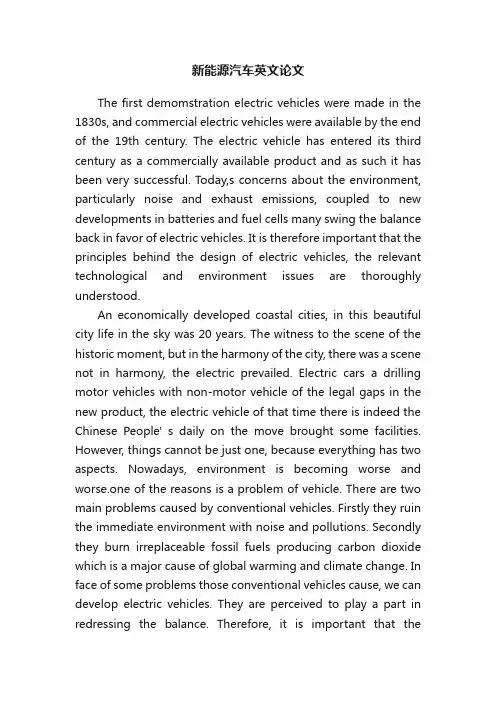
新能源汽车英文论文The first demomstration electric vehicles were made in the 1830s, and commercial electric vehicles were available by the end of the 19th century. The electric vehicle has entered its third century as a commercially available product and as such it has been very successful. Today,s concerns about the environment, particularly noise and exhaust emissions, coupled to new developments in batteries and fuel cells many swing the balance back in favor of electric vehicles. It is therefore important that the principles behind the design of electric vehicles, the relevant technological and environment issues are thoroughly understood.An economically developed coastal cities, in this beautiful city life in the sky was 20 years. The witness to the scene of the historic moment, but in the harmony of the city, there was a scene not in harmony, the electric prevailed. Electric cars a drilling motor vehicles with non-motor vehicle of the legal gaps in the new product, the electric vehicle of that time there is indeed the Chinese People' s daily on the move brought some facilities. However, things cannot be just one, because everything has two aspects. Nowadays, environment is becoming worse and worse.one of the reasons is a problem of vehicle. There are two main problems caused by conventional vehicles. Firstly they ruin the immediate environment with noise and pollutions. Secondly they burn irreplaceable fossil fuels producing carbon dioxide which is a major cause of global warming and climate change. In face of some problems those conventional vehicles cause, we can develop electric vehicles. They are perceived to play a part in redressing the balance. Therefore, it is important that theenvironmental impact of electric vehicles is thoroughly known.After a few years of development, the rapid growth of electric vehicles become the focus of industry related to people's livelihood, its rapid development speed is amazing. Thinking carefully, the electric car industry in the folk is so popular for a reason: first, low carbon environmental protection, in line with national environmental protection requirements; second, light and flexible, make people travel convenience; third, high performance and low price , make people love them. The electric vehicles advantage determines the development of high-speed electric vehicle industry. The electric car industry has rapid development, growth, maturity.World electric vehicle research test after the development of 20 years, has entered a new stage, that is, small batch production and commercialization to the actual application of the market. According to incomplete statistics, the current global electric car about 13000 vehicles in use. At present, our country electric car overall is still in the research stage of the key unit techniques, and guided by the market the unit will be the technology of integrated development, meet the vehicle a particular user requirements, through the use of testing and improvement, technology has matured to become official products.We would say electric vehicles the advantages and disadvantages, and only through the only revealed a number of very serious problem. First, let us say electric vehicles to the people of the benefits, section to environmental protection, and faster than other than motor vehicles soon, and low cost without a licence, driving easily, both young and old suitable "four points mentioned above is electric bicycle in the minds of most people recognized advantage. Now let us look at electric cars thedefects and what other places, electric battery should not be permanent, cell damage, replacement rate is high, but battery recovery in the country is still relatively low, this does not fully comply with section to environmental protection concepts, and speed is indeed a bicycle faster than the motor vehicle slow。

汽车营销英文作文英文:As a car marketer, I believe that the key to successful car marketing is understanding your target audience. You need to know what they want and what they need in a car. This means doing market research and analyzing data to get a clear picture of your audience.Once you have this information, you can tailor your marketing messages to appeal to your target audience. For example, if your target audience is young families, you might focus on the safety features of your cars and how they can protect their children. On the other hand, if your target audience is young professionals, you might focus on the technology features of your cars and how they can make their lives easier.Another important aspect of car marketing is creating a strong brand image. Your brand should be unique andmemorable, and it should communicate the values andbenefits of your cars. This can be achieved through advertising, social media, and other marketing channels.Ultimately, the goal of car marketing is to create a connection between your brand and your target audience. You want them to feel like your cars are the best choice for them, and that they can trust your brand to deliver quality and reliability.中文:作为一名汽车营销人员,我认为成功的汽车营销的关键是了解你的目标受众。
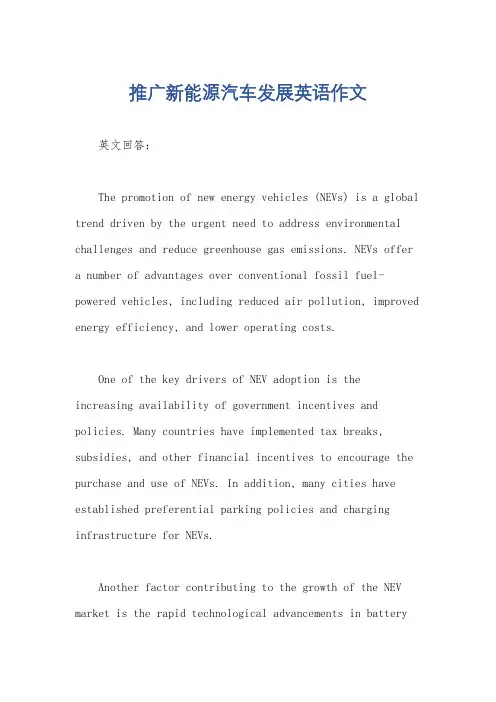
推广新能源汽车发展英语作文英文回答:The promotion of new energy vehicles (NEVs) is a global trend driven by the urgent need to address environmental challenges and reduce greenhouse gas emissions. NEVs offer a number of advantages over conventional fossil fuel-powered vehicles, including reduced air pollution, improved energy efficiency, and lower operating costs.One of the key drivers of NEV adoption is the increasing availability of government incentives and policies. Many countries have implemented tax breaks, subsidies, and other financial incentives to encourage the purchase and use of NEVs. In addition, many cities have established preferential parking policies and charging infrastructure for NEVs.Another factor contributing to the growth of the NEV market is the rapid technological advancements in batterytechnology. The energy density and lifespan of batteries have improved significantly in recent years, making NEVs more practical and affordable for consumers. Additionally, the development of new battery chemistries is expected to further enhance the performance and cost-effectiveness of NEVs in the future.The promotion of NEVs also aligns with broader sustainability goals. By reducing air pollution and greenhouse gas emissions, NEVs contribute to a cleaner and healthier environment. Furthermore, the increased use of renewable energy sources for electricity generation can make NEVs even more sustainable.In conclusion, the promotion of new energy vehicles is essential for addressing environmental concerns, reducing greenhouse gas emissions, and advancing sustainable transportation. Continued government support, technological advancements, and consumer awareness are all crucial for accelerating the adoption of NEVs and achieving a cleaner and more sustainable future.中文回答:新能源汽车发展的推广。
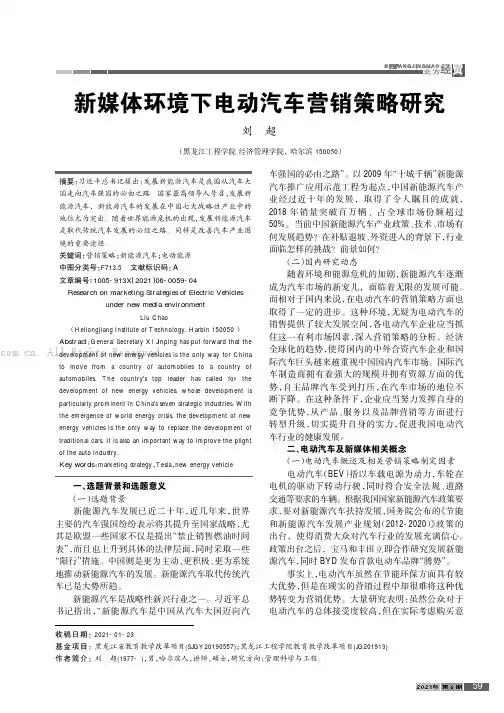
摘要:习近平总书记提出:发展新能源汽车是我国从汽车大国走向汽车强国的必由之路。
国家最高领导人号召,发展新能源汽车,新能源汽车的发展在中国七大战略性产业中的地位尤为突出。
随着世界能源危机的出现,发展新能源汽车是取代传统汽车发展的必经之路。
同样是改善汽车产业困境的重要途径。
关键词:营销策略;新能源汽车;电动能源中图分类号:F713.5文献标识码:A文章编号:1005-913X (2021)06-0059-04Research on marketing Strategies of Electric Vehiclesunder new media environmentLiu Chao(Heilongjiang Institute of Technology,Harbin 150050)Abstract :General Secretary Xi Jinping has put forward that thedevelopment of new energy vehicles is the only way for Chinato move from a country of automobiles to a country of automobiles.The country's top leader has called for the development of new energy vehicles,whose development is particularly prominent in China's seven strategic industries.With the emergence of world energy crisis,the development of new energy vehicles is the only way to replace the development of traditional cars.It is also an important way to improve the plight of the auto industry.Key words :marketing strategy ,Tesla ,new energy vehicle收稿日期:2021-01-23基金项目:黑龙江省教育教学改革项目(SJGY20190557);黑龙江工程学院教育教学改革项目(JG201913)作者简介:刘超(1977-),男,哈尔滨人,讲师,硕士,研究方向:管理科学与工程。
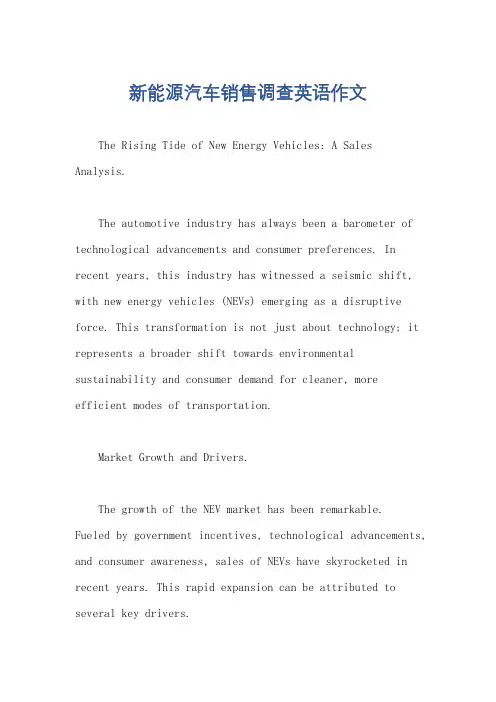
新能源汽车销售调查英语作文The Rising Tide of New Energy Vehicles: A Sales Analysis.The automotive industry has always been a barometer of technological advancements and consumer preferences. In recent years, this industry has witnessed a seismic shift, with new energy vehicles (NEVs) emerging as a disruptive force. This transformation is not just about technology; it represents a broader shift towards environmental sustainability and consumer demand for cleaner, moreefficient modes of transportation.Market Growth and Drivers.The growth of the NEV market has been remarkable.Fueled by government incentives, technological advancements, and consumer awareness, sales of NEVs have skyrocketed in recent years. This rapid expansion can be attributed to several key drivers.Firstly, government policies have played a pivotal role. Many countries, including China, the United States, and European Union member states, have implemented subsidy schemes, tax incentives, and other measures to encouragethe adoption of NEVs. These policies have not only reduced the upfront cost of NEVs but have also created a favorable environment for research and development in this field.Secondly, technological advancements have been crucial. Battery technology, in particular, has made significant progress, leading to improved range, faster charging times, and reduced costs. This has made NEVs more competitive with traditional gasoline-powered vehicles.Thirdly, consumer preferences are shifting. With rising concerns about climate change and air pollution, consumers are increasingly demanding cleaner modes of transportation. Additionally, the rising cost of fuel and maintenance has made NEVs a more economically viable option for many.Market Segmentation.The NEV market can be segmented into several categories based on technology and application. The most common types of NEVs are battery electric vehicles (BEVs), plug-in hybrid electric vehicles (PHEVs), and fuel cell electric vehicles (FCEVs).BEVs are powered solely by electricity stored in batteries. They offer the cleanest and most efficient form of motoring but typically have a higher upfront cost and shorter range than other NEVs. PHEVs combine a traditional internal combustion engine with an electric motor and batteries, offering the best of both worlds in terms of range and fuel efficiency. FCEVs use hydrogen fuel cells to generate electricity, emitting only water vapor as a by-product. While they offer zero-emission driving, the infrastructure for hydrogen fueling stations is still limited.In terms of application, NEVs are finding their wayinto various sectors, including passenger cars, commercial vehicles, and public transportation. Passenger car saleshave been the main driver of NEV growth, but the commercial vehicle and public transportation segments are also showing promise.Market Challenges and Opportunities.Despite the significant growth of the NEV market, several challenges remain. One of the biggest obstacles is the lack of infrastructure, particularly charging stations and hydrogen fueling stations. This limits the range and convenience of NEVs, affecting their adoption rates.Another challenge is the cost of batteries, which still accounts for a significant portion of the overall cost of NEVs. While battery prices have been trending downwards, further cost reductions are needed to make NEVs more affordable for a wider range of consumers.Despite these challenges, the opportunities for the NEV market are immense. As technology improves and infrastructure expands, the potential for NEVs to replace traditional gasoline-powered vehicles is巨大. This couldlead to significant reductions in greenhouse gas emissions and air pollution, making a positive impact on global climate change efforts.Conclusion.The rise of new energy vehicles represents a seismic shift in the automotive industry. Fueled by government policies, technological advancements, and changing consumer preferences, the NEV market is poised for continued growth. While challenges remain, the opportunities for this market are immense, offering the promise of a cleaner, more sustainable future for transportation. As we move towards a more sustainable future, it will be crucial to address the challenges and seize the opportunities presented by therise of new energy vehicles.。
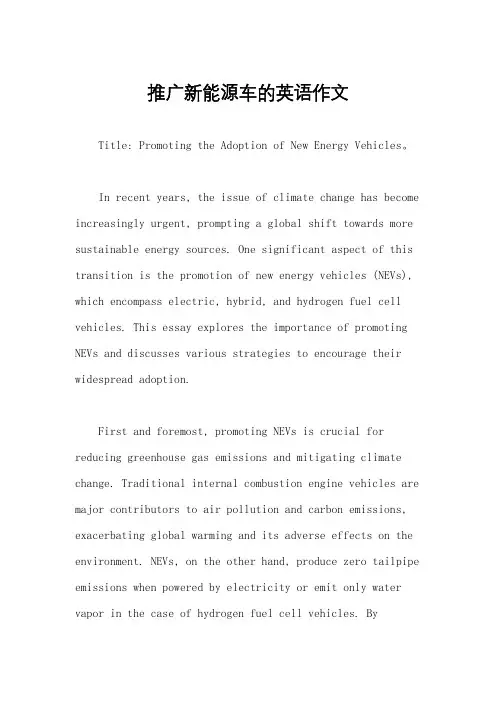
推广新能源车的英语作文Title: Promoting the Adoption of New Energy Vehicles。
In recent years, the issue of climate change has become increasingly urgent, prompting a global shift towards more sustainable energy sources. One significant aspect of this transition is the promotion of new energy vehicles (NEVs), which encompass electric, hybrid, and hydrogen fuel cell vehicles. This essay explores the importance of promoting NEVs and discusses various strategies to encourage their widespread adoption.First and foremost, promoting NEVs is crucial for reducing greenhouse gas emissions and mitigating climate change. Traditional internal combustion engine vehicles are major contributors to air pollution and carbon emissions, exacerbating global warming and its adverse effects on the environment. NEVs, on the other hand, produce zero tailpipe emissions when powered by electricity or emit only water vapor in the case of hydrogen fuel cell vehicles. Bytransitioning to NEVs, we can significantly reduce air pollution and curb the detrimental impacts of climate change.Additionally, promoting NEVs contributes to energy security and reduces dependence on finite fossil fuels. Unlike conventional vehicles that rely on gasoline or diesel, NEVs can be powered by electricity generated from renewable sources such as solar, wind, and hydroelectric power. By utilizing domestic renewable energy resources, countries can enhance their energy independence and resilience to supply disruptions. Moreover, the widespread adoption of NEVs can help alleviate concerns about oil depletion and geopolitical tensions associated with fossil fuel extraction and distribution.Furthermore, promoting NEVs presents economic opportunities and fosters innovation in the automotive industry. As the demand for NEVs grows, manufacturers are incentivized to invest in research and development to improve battery technology, increase vehicle range, and reduce costs. This innovation spillover effect can driveadvancements not only in the automotive sector but also in related industries such as renewable energy, energy storage, and smart grid technologies. Moreover, the production and deployment of NEVs create jobs in manufacturing, sales, maintenance, and infrastructure development, stimulating economic growth and prosperity.To effectively promote the adoption of NEVs, governments, businesses, and other stakeholders must implement comprehensive strategies. One key strategy is to provide financial incentives and subsidies to make NEVsmore affordable and competitive with conventional vehicles. These incentives may include purchase rebates, tax credits, and exemptions from vehicle registration fees or road tolls. Additionally, governments can establish regulations and mandates to encourage automakers to produce more NEVs and expand charging infrastructure. This may involve setting emission standards, fuel economy targets, and zero-emission vehicle (ZEV) mandates, as well as investing in public charging stations and incentivizing private charging infrastructure deployment.Moreover, public awareness and education campaigns are essential to dispel myths and misconceptions about NEVs and highlight their benefits. By disseminating accurate information about NEV technology, performance, and cost savings, consumers can make informed decisions when purchasing vehicles. Furthermore, showcasing successstories and testimonials from NEV owners can inspire confidence and encourage others to make the switch to cleaner transportation options.In conclusion, promoting the adoption of new energy vehicles is imperative for addressing climate change, enhancing energy security, and fostering economic growth. By implementing comprehensive strategies and incentives, we can accelerate the transition towards a more sustainable and resilient transportation system. Together, we can drive positive change and create a cleaner, healthier, and more prosperous future for generations to come.。
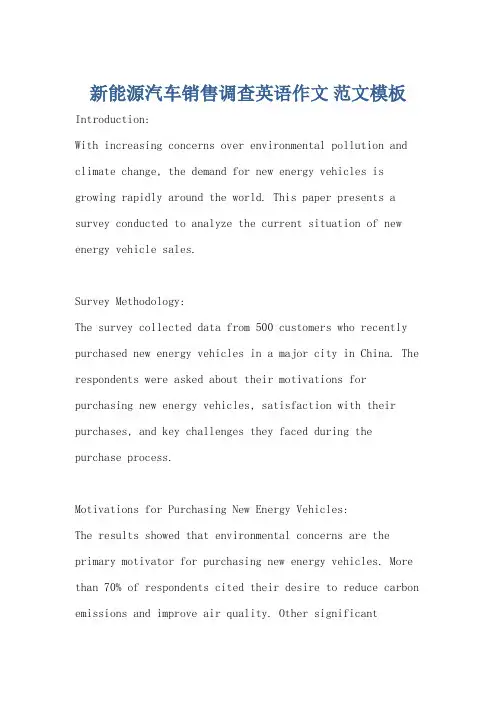
新能源汽车销售调查英语作文范文模板Introduction:With increasing concerns over environmental pollution and climate change, the demand for new energy vehicles is growing rapidly around the world. This paper presents a survey conducted to analyze the current situation of new energy vehicle sales.Survey Methodology:The survey collected data from 500 customers who recently purchased new energy vehicles in a major city in China. The respondents were asked about their motivations for purchasing new energy vehicles, satisfaction with their purchases, and key challenges they faced during the purchase process.Motivations for Purchasing New Energy Vehicles:The results showed that environmental concerns are the primary motivator for purchasing new energy vehicles. More than 70% of respondents cited their desire to reduce carbon emissions and improve air quality. Other significantfactors included cost savings on fuel (15%) and government subsidies (10%).Satisfaction with New Energy Vehicle Purchases:The survey found that overall customer satisfaction withnew energy vehicles is high. Nearly 90% of respondents indicated that they are satisfied or very satisfied with their purchases. The most common reasons cited for this satisfaction were low operating costs (30%), quiet driving experience (25%), and government subsidies (20%).Challenges Faced During New Energy Vehicle Purchase Process: Despite general satisfaction with purchases, many respondents encountered significant challenges during the purchase process. Most commonly, these challenges centered around charging infrastructure availability (40%), limited model options (30%), and high purchase prices (20%).Conclusion:In conclusion, our survey findings suggest that while environmental concerns are driving increased sales of new energy vehicles, there are still significant challengesthat need to be addressed. Policy efforts to improve charging infrastructure availability and expand model options could further boost sales in this sector. Additionally, efforts to reduce purchase prices could also help increase adoption rates among more price-sensitive consumers.。
AUTO AFTERMARKET | 汽车后市场新媒体环境下新能源汽车营销策略研究张建良西安外事学院 陕西省西安市 710105摘 要: 新能源汽车是未来汽车的发展方向,做好新能源汽车的营销工作是实现企业发展具有重要的意义。
然而,目前汽车销售企业并不能很好的应用新媒体来助力新能源汽车的营销,企业必须打破固有的思维壁垒,紧跟时代的潮流,在创新中实现广阔的发展,从新媒体渠道、客户沟通、广告宣传和售后服务四个角度加强新能源汽车的营销,从而获得消费者的认可并扩展企业的市场占有率。
关键词:新媒体环境 新能源汽车 新能源汽车营销伴随着信息技术的发展,人们获取商品信息途径越来越多,尤其是以微博、微信公众号、视频直播等为代表的新媒体崛起,导致消费者的行为方式也发生巨大改变,从新媒体上获取商品信息成为消费者的日常行为。
电动汽车消费也是如此,越来越多的消费者通过各种新媒体获取新能源汽车的信息,而新媒体也成为汽车厂商开展营销的重要阵地,运用好基于新媒体的营销策略是新能源车企业实现自身发展的重要条件。
1 新能源汽车基于新媒体营销的意义新能源汽车是相对于传统以化石燃料为动力的汽车而言,又称为“低公害汽车”,指采用非常规的车用燃料作为动力来源的汽车,包括混合动力、纯电动、燃料电池、氢动力等为动力的新型汽车。
目前我国市场最常见的新能源汽车主要为混合动力汽车和纯电动汽车。
伴随着世界各国纷纷确定在未来数十年内要取代传统化石能源汽车,新能源汽车逐渐成为汽车市场的热点,而新能源汽车的营销也成为汽车销售企业的重要内容。
以微信、微博、抖音为代表的新媒体具有传播速度快、传播范围广泛和交互性强的特点,对于新能源汽车的营销有三方面的优点:1.1 新媒体有助于提升新能源汽车的营销范围基于新媒体的营销模式完全打破汽车销售的地域限制,大大扩展了汽车的销售范围,同时,也提升新能源汽车的信息传播速度,营销人员可以利用社交媒体可以向远距离的消费者推销新能源汽车产品和服务。
新功能新能源汽车英语作文New energy vehicles are becoming increasingly popularin today's society. With the advancement of technology, these vehicles are not only environmentally friendly, but also offer a range of new features that make them an attractive option for consumers.One of the most exciting new features of new energy vehicles is their fast-charging capabilities. Unlike traditional vehicles, which can take hours to refuel, new energy vehicles can be charged in a fraction of the time. This is a game-changer for drivers who are used to long waits at the gas station.In addition to fast-charging, new energy vehicles also offer advanced safety features. Many models come equipped with autonomous driving capabilities, collision avoidance systems, and advanced airbag technology. These features not only make driving safer, but also provide peace of mind for drivers and passengers.Another benefit of new energy vehicles is their lower maintenance costs. With fewer moving parts and a simpler engine design, these vehicles require less frequent maintenance and are less prone to mechanical issues. This can save drivers a significant amount of money over thelife of the vehicle.Furthermore, new energy vehicles are paving the way for a more sustainable future. By reducing our reliance on fossil fuels, these vehicles help to mitigate the impact of climate change and reduce air pollution. This is an important step towards creating a cleaner, healthier planet for future generations.Overall, the new features of new energy vehicles make them an appealing choice for consumers. From fast-charging capabilities to advanced safety features, these vehicles offer a range of benefits that make them a compelling option for drivers looking to embrace the future of transportation.。
164AUTO TIMEAUTO AFTERMARKET | 汽车后市场媒体整合背景下新能源汽车市场营销策略研究黄茜柳州铁道职业技术学院 广西柳州市 545616摘 要: 在绿色经济背景下,新能源汽车得到广泛的关注,成为推动汽车行业绿色环保工作实施的重要因素。
为了促使新能源汽车销售活动顺利进行,文章以媒体整合背景下新能源汽车市场营销策略为研究对象,对媒体整合进行简单的阐述。
基于新能源市场营销思路,对如何发挥媒体整合的优势,促使汽车销售工作开展,提出几点建议,希望为相关人士提供一定价值参考。
关键词:媒体整合 新能源汽车 市场营销 策略1 引言在新能源汽车市场营销中,新媒体发挥着重要的作用,不仅拓展销售范围、渠道,同时也增加新能源汽车的汽车行业中的影响力,使更多人民群众认识、了解新能源汽车。
如何在新能源汽车市场营销中,发挥媒体整合的作用,提升销售量呢?本文就此进行分析。
2 媒体整合媒体整合,是一种对不同营销工具、营销手段系统化融合,根据环境变化进行动态修正,以使交换双方在交互中实现价值增值的营销理念与方法。
在市场营销中,媒体整合的运用比较常见,具有提升销售效果,提升产品市场影响力的作用[1]。
与传统营销方式相比,媒体整合主要具备以下特点:第一,丰富的信息传播渠道。
信息技术快速发展,对人民群众生活、学习、工作产生较大的影响,接触网络的渠道也越来越广泛,为获取多元信息提供便利。
与以往电视媒体、报纸等信息传播方式对比,媒体融合的发展,丰富信息传播渠道,人民群众可以利用手机、电脑等载体获取网络信息、传播信息。
新媒体的出现,人民群众不仅信息的接收者,也是信息的传播者,可以在互联网中转发、评论信息,群众的话语权得到凸显。
媒体融合的发展,为市场营销活动开展提供内在动力,市场营销人员可以利用媒体融合丰富信息传播渠道进行宣传推广,扩大产品的市场战略率,提升市场营销水平。
第二,多元化信息种类。
在全球化背景下,人们的审美出现多元化的发展趋势,对信息的要求逐渐提升。
推广新能源汽车发展英语作文English:As the world increasingly focuses on sustainability and reducing carbon emissions, promoting the development of new energy vehicles has become crucial. New energy vehicles, including electric vehicles and hydrogen fuel cell vehicles, have significant advantages in terms of environmental protection and energy conservation. By widely promoting the use of these vehicles, we can effectively reduce air pollution, combat climate change, and achieve long-term energy security. Governments, industries, and consumers all play a crucial role in promoting the development and adoption of new energy vehicles. Governments can provide incentives, subsidies, and infrastructure support to encourage the production and use of new energy vehicles. Industries can invest in research and development to improve the technology and performance of these vehicles. Consumers can choose to purchase new energy vehicles and support the growth of the market. Overall, promoting new energy vehicles is not only a way to combat environmental challenges but also a way to drive innovation, create jobs, and improve public health.中文翻译:随着世界越来越关注可持续发展和减少碳排放,推动新能源汽车的发展变得至关重要。
新能源汽车产品计划书**English Version****Introduction**As the world is increasingly becoming aware of the need to adopt sustainable practices, the automotive industry is no exception. The rise of electric vehicles (EVs) and hybrid electric vehicles (HEVs) has marked a significant shift towards greener modes of transportation. Our company aims to capitalize on this trend by introducing a new line of advanced new energy vehicles (NEVs) that offer a seamless blend of performance, efficiency, and environmental friendliness.**Market Analysis**The global market for NEVs is expected to grow exponentially in the coming years, driven by factors such as government policies promoting clean energy, consumer demand for eco-friendly products, and technological advancements in battery technology. Our target market consists of environmentally conscious consumers who arelooking for high-quality, cost-effective, and sustainable transportation solutions.**Product Features**Our new line of NEVs will be equipped with cutting-edge features that set them apart from the competition. These features include:* **Advanced Battery Technology:** Our vehicles will use the latest lithium-ion batteries, offering longer range and faster charging times. * **Sophisticated Design:** The exterior and interior designs will be sleek and modern, focusing on aerodynamic efficiency and passenger comfort. * **Smart Connectivity:** The vehicles will come with state-of-the-art infotainment systems, including GPS navigation, voice control, and wireless connectivity. * **Safety Features:** Safety will be a top priority, with features like collision avoidance systems, automatic braking, and stability control.**Marketing Strategy**To reach our target market, we will employ acombination of traditional and digital marketing strategies. This includes:* **Advertising:** We will advertise our products through print, television, and online media, highlighting their environmental benefits and advanced features. ***Social Media:** We will use social media platforms to engage with potential customers, sharing updates on new products, events, and industry news. * **Partnerships:** We will seek partnerships with government agencies, non-profit organizations, and other businesses to promote the adoption of NEVs.**Financial Plan**Our financial plan calls for a phased approach to production and marketing. Initial investments will be focused on research and development, followed by the construction of a manufacturing facility and the launch of our first line of NEVs. We anticipate achievingprofitability within the first three years of operations, with revenue growth driven by increasing sales and market expansion.**Conclusion**The automotive industry is poised for a major transformation, and our company is poised to lead the way. With our new line of advanced NEVs, we aim to provide consumers with a viable and attractive alternative to traditional gasoline-powered vehicles. By focusing on innovation, quality, and sustainability, we believe we can capture a significant share of the growing NEV market.**中文版本****新能源汽车产品计划书****介绍**随着全球对可持续实践的日益重视,汽车行业也不例外。
关于新能源汽车的产品计划书英文英文回答:Product Plan for New Energy Vehicles (NEVs)。
Executive Summary.The global automotive industry is undergoing asignificant transformation, driven by the need to reduce greenhouse gas emissions and improve urban air quality. New energy vehicles (NEVs), which include electric vehicles (EVs), hybrid electric vehicles (HEVs), and fuel cell vehicles (FCVs), are playing an increasingly important role in this transition.This product plan outlines our company's strategy for developing and commercializing NEVs. We believe that NEVs have the potential to revolutionize the automotive industry, and we are committed to being a leader in this important market.Market Analysis.The global NEV market is growing rapidly, driven by government incentives, technological advancements, and increasing consumer demand. In 2022, global NEV sales are expected to reach 10 million units, and this number is projected to grow to 40 million units by 2030.The major markets for NEVs are China, Europe, and the United States. China is the largest NEV market in the world, accounting for over 50% of global sales. Europe is the second largest market, with a growing number of countries adopting strict emissions regulations. The United States is a relatively small NEV market, but it is growing rapidly.Competitive Landscape.The NEV market is highly competitive, with a number of major automakers investing heavily in this sector. The leading NEV manufacturers include Tesla, BYD, Volkswagen, and Toyota.Tesla is the world's leading EV manufacturer, with a dominant position in the luxury EV market. BYD is a Chinese automaker that is a major player in both the EV and HEV markets. Volkswagen is a German automaker that is investing heavily in EVs, with the goal of becoming the world's largest EV manufacturer by 2025. Toyota is a Japanese automaker that is a leader in the HEV market, and is also developing EVs and FCVs.Product Strategy.Our company's NEV product strategy is focused on developing and commercializing a range of NEVs that meet the needs of different customer segments. Our product portfolio will include EVs, HEVs, and FCVs, with a focus on providing affordable, efficient, and reliable vehicles.We will leverage our strong engineering and manufacturing capabilities to develop NEVs that are competitive in terms of performance, range, and cost. We will also offer a range of value-added features, such asadvanced driver assistance systems (ADAS), infotainment systems, and over-the-air (OTA) updates.Marketing and Sales Strategy.Our marketing and sales strategy for NEVs will focus on building awareness of our products, generating leads, and driving sales. We will use a variety of marketing channels, including online advertising, social media, and public relations. We will also participate in NEV trade shows and events.Our sales strategy will focus on building relationships with potential customers and providing them with the information they need to make informed purchasing decisions. We will also offer a range of incentives, such as discounts, rebates, and loyalty programs.Sustainability Strategy.Our company is committed to sustainability, and we believe that NEVs are an essential part of our efforts toreduce our environmental impact. We design and manufacture our NEVs with sustainability in mind, using eco-friendly materials and processes. We also offer recycling programs for our end-of-life vehicles.Financial Projections.We project that our NEV business will generate significant revenue and profit over the next five years. We expect our NEV sales to grow rapidly, driven by increasing demand and our competitive product offerings. We also expect to benefit from economies of scale as our production volumes increase.Conclusion.We believe that NEVs have the potential torevolutionize the automotive industry and make asignificant contribution to reducing greenhouse gas emissions and improving urban air quality. Our company is committed to being a leader in this important market, and we are confident that our product plan will enable us toachieve our goals.中文回答:新能源汽车产品计划书。
新媒体背景下新能源汽车品牌营销策略英
文文献
increasing oil prices due to oil depletion, global warming and the introduction of compulsory standard gas emissions in cities have had a tremendous impact on the development of new trans-potations technologies [1i in hybrid electric vehicles (HEVs). renewable energy is a new option for improving vehicle efficiency and is economical with lower toxic gas emission to achieve the same power and density energy as a combustion engine. FCs with batteries and SCs are combined to provide additional power rapidly during high demand and to overcome the FC start-time [2]. In many Asian countries, scooters and three-wheeled vehicles are notably popular and are a cheaper form of transportation. They are often used in the cities to travel short distances and avoid trap-fic jams. These vehicles have a capacity of 2-5 kW from an internal combustion engine (ICE). Recently, due to consumers” concern for the environment, small HEVs have been introduced with a power system and no longer use an ICE. For example, three-wheeled rick-Shaw drive train with a hybrid configuration, plug-in electric rick-Shaw with solar assistance [3.4] and FC-
battery powered hybrid system for a tramway have been introduced 5J. This study focused on an EMS in which a control strategy is developed to provide tramway load demand or to optimize the system's energy.
Power sharing and hybridization of FC. battery. Sc from literature review [6-8] shows that controls strategies play a vital rollatini proving vehicle performance and efficiency.it coordinates the power sources to secure the electrical flow of the system. In addition, study of various drive train systems such as series. parallel, series/parallel motor and generator system in electric vehicle in [9-11] encourages the development of HEV in maximizes fuel economy. durability and reliability. Power electronics such asdic/dc converter and inverter has become a major study of Here siarch in for improving power conditioning system. LEV system like electric scooter has also become an interesting system studied in [15-171 The EMS system and controlling in-wheel motor is the major concerned of the research. All mentioned liter-nature review is summarized in Table 1 in relation of HEV
technical characteristics with applied renewable energies.
ln Malaysia. LEV vehicles such as motorcycles or
scooter (range70-125 cc) are widely used for personal transportation such as to office, shopping. schools and etc. Unlike in Europe, USA or Japan. Such transportations are used as recreation. It is estimated that half of the vehicle are used to travel 20 km below per day and half of them may travel more than 30 ken per day [18J. People are unreal-sized that with traveling distance less than 20 km per day. vehicle powered by battery can be used without any refueling stop. The electric vehicle can be recharged at home as well. University Kembangan Malaysia studies harvesting solar energy system through solar car park This study also included the construction of solar car park in the city in terms of economical and technical aspect.。